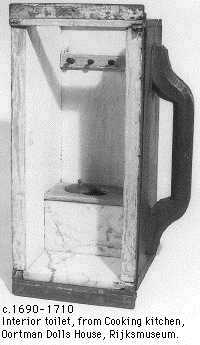

Inventory: "A pewter chamber pot, een tinne waterpoth ; Ten pewter spoons, tien tinne lepels. Three pewter chamber pots, drye tinne waterpotten ; A copper kettle, een kopere ketel."
See the original documents from the Delft Archives. Goods owned by Catharina Bolnes, page 1, page 2, page 3, page 4, page 5, page 6, page 7. Goods jointly owned by Catharina Bolnes and Maria Thins, page 1, page 2, page 3, page 4, page 5, page 6.
Full, smelly chamber pots were stored there in the open air until they could be emptied - see trash and excrement.
 In
the yard there was probably an underground rainwater reservoir for
the scullery and washing kitchen.
In
the yard there was probably an underground rainwater reservoir for
the scullery and washing kitchen.
In the property of more luxurious homes pumps near the cooking kitchens were connected to both wells and to rainwater resevoirs. That explains why two pump handles and two faucets were needed for water to be pumped up. (Pijzel, Pronkpoppenhuis, 2000, p. 167)
However, at the Thins/Vermeer house the yard was too far away from the cooking kitchen or inner kitchen (D). If there was a reservoir, it may have been connected to the scullery 'agter keukentgen' (J)' and the washing kitchen 't waskeukentgen' (K)'.
If there was a toilet in the house, it could have been placed in the yard, reachable either from within the house or via the open air. Alternatively the toilet could have been placed in the inner kitchen, such as in the van Oortman Dolls House (Rijksmuseum, Amsterdam) or in another room. Finally there is the option that only chamber pots were used. Chamber pots were emptied in so called straw waste barges for waste, 'stro-schuiten' which went on scheduled times through the canals. See also the box-shaped secreet koffer (Pijzel, Pronkpoppenhuis, 2000, p. 178.). For outhouses, also see Fock 2001.
Relieving oneself on the public roads, or in small outhouses over the water near a canal bridge was a normal thing to do. Thus canal water was not very clean.
Note : These objects were part of the Vermeer-inventory as listed by by the assistant of Delft notary public J. van Veen on February 29, 1676, in the Thins/Vermeer home located on Oude Langendijk on the corner of Molenpoort. The painter Johannes Vermeer had died there at the end of December 1675. His widow Catherina and their eleven children still lived there with her mother Maria Thins.
The transcription of the 1676 inventory, now in the Delft archives, is based upon its first full publication by A.J.J.M. van Peer, "Drie collecties..." in Oud Holland 1957, pp. 98-103. My additions and explanations are added within square brackets [__]. Dutch terms have been checked against the world's largest language dictionary, the Dictionary of the Dutch Language (Woordenboek der Nederlandsche Taal , or WNT), which was begun by De Vries en Te Winkel in 1882.C. Willemijn Fock, Titus M. Eliëns, Eloy F. Koldeweij, Jet Pijzel Dommisse, Het Nederlandse interieur in beeld 1600 - 1900 Waanders, Zwolle 2001, page 24.
This page forms part of a large encyclopedic site on Vermeer and Delft. Research by Drs. Kees Kaldenbach (email). A full presentation is on view at johannesvermeer.info.
Launched December, 2002; Last update March 1, 2017.
Back to the Welcome page: click Welcome.